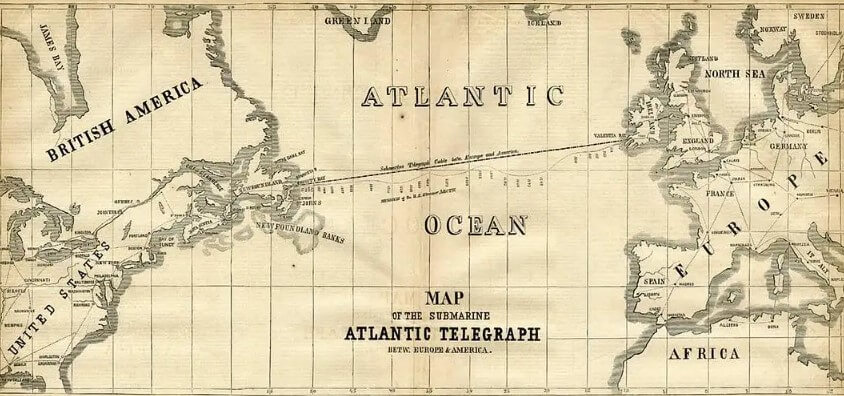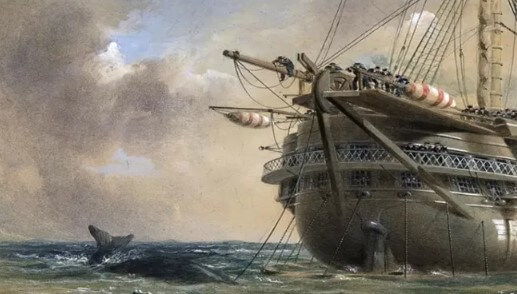the arrival of the gutapercha in the 19th century he made the idea of a telegraph cable across the ocean a reality. Metallic cables wrapped in gutta-percha could be placed at the bottom of the sea. Electricity could flow through them without being affected by the sea.
Engineer John Watkins Brett laid the first submarine cable across the English Channel in 1851. This made it possible to successfully connect Great Britain with the European continent..
With that, attention turned to the North American continent: could north america be connected to europe? At that time, the knowledge and application of electricity were still in their infancy. It was also not known what the underwater topography of the Atlantic Ocean was really like..
even Morse, the inventor of the telegraph, thought a transatlantic submarine telegraph cable was an impractical idea.

Project of the first transatlantic intercontinental submarine cable
In 1854, British engineer Gisborne was commissioned to lay a submarine cable from New York to Newfoundland. But problems arose with the financing of the project, so he went to new york to seek the help of investors. There he met Cyrus West Field, a wealthy american.
Field was young and rich. Although I had no technical knowledge, had a great vision of the farthest future. After investing in the submarine cable between New York and Newfoundland, Field immediately devoted himself to the ambitious project of a transatlantic submarine cable.
From the technical point of view, the cable that crosses the English Channel and the transatlantic cable are not at all comparable. A calm day was enough to lay the cable that crosses the English Channel. And at that time the ships had to sail for almost three weeks or more to cross the Atlantic. Just the weight of the entire transatlantic cable, not counting the laying machinery, far exceeded the capacity of any ship of the time.
The British government provided Field with the HMS Agamemnon, one of the largest ships in the Royal Navy. And the American government the Niagara, from 5.000 tons. these two boats, the largest in their tonnage class at the time, they were specially modified so that each of them could lay half of the transoceanic cable.
The submarine transoceanic cable it had to be very resistant and could not break. Nevertheless, the cable had to be very flexible at the same time, otherwise it would have been difficult to place. Besides, its manufacture must be very precise. On the contrary, the slightest defect could cause instability and interruption of the electrical signal.
First attempt
Field's laying fleet sailed from Ireland on 5 of august 1857. After successfully traversing 355 nautical miles, an accident occurred. The winch malfunctioned. And all the cable that had been laid fell into the sea. At that time, there was no suitable diving technology available to pull the cables from the bottom of the sea.. The first attempt was declared a failure.. field lost 355 nautical miles of cable and an investment of 100.000 pounds.
Second try
The 10 June 1858, Field's convoy departed for the second time. Unfortunately, the convoy was caught in a storm before reaching its destination in the middle of the ocean. HMS Agamemnon escaped and reached her intended destination without incident. Nevertheless, after the storm, the cable was affected and suffered serious damage. After more than 200 nautical miles of laying, the two ends of the cable could no longer communicate with each other. The second attempt failed again..
This failure shook the confidence of most investors. Many demanded that Field sell the remaining cables to cover their losses.. There was also an outcry in the media, with skepticism everywhere. But Field was determined to try again..

Third try
The 17 July 1858, the fleet set sail again. In the 28 of July, HMS Agamemnon and Niagara successfully joined in the mid-Atlantic to start the laying of the transoceanic cable. After coupling half of the cable in each ship, the Niagara left for the United States and the HMS Agamemnon for the United Kingdom. The 5 of August, the Niagara reached the coast of Newfoundland and the Agamemnon that of Ireland on the same day.
The 16 of august 1858, a message from Queen Victoria to President Buchanan reached North America via submarine cable. This heralded a great moment in the history of mankind..
But fate was cruel. A few days later, the submarine cable was disconnected. North America could no longer receive a clear signal from Europe. The submarine cable Field had worked so hard to lay was junk again, and he was in disrepute..
fourth attempt
But Field did not allow himself to be defeated by fate.. In 1865 reappeared in London to relaunch his project of transoceanic cable under the sea. Then, research on cable telegraphy was well established. Besides, the largest ship in the world was built, el Great Eastern. The Great Eastern set sail in the 23 of July. But two days before the trip to North America, the cable suddenly broke. The fourth attempt failed again.
fifth try
The Great Eastern set sail again 13 July 1866. Shortly after, managed to find the cable that had failed last time and continued to place it. This time the attempt was finally successful. The two cables brought Europe and North America closer. At the time, this was a miracle of the times.
In more than ten years, Field failed five times and hundreds of thousands of pounds went down the drain. But still he didn't give up. The vastness of the ocean was no longer an insurmountable barrier to information.
